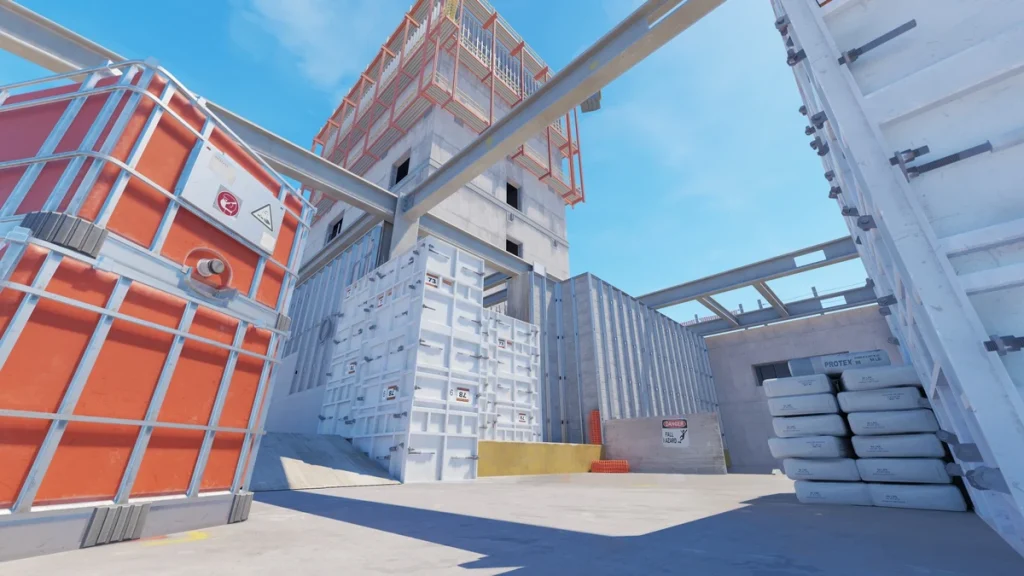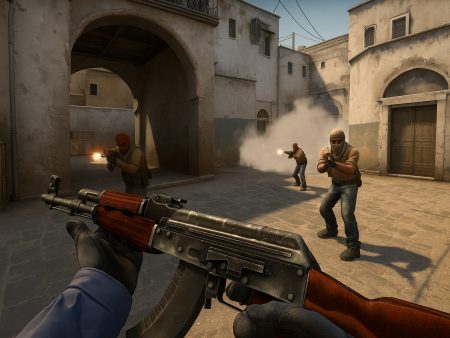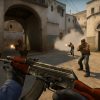Master CS2’s Vertigo map with this complete guide covering detailed callouts, pro strategies, utility lineups, and solo/competitive tips to dominate every match.
Vertigo is one of the most unique and controversial maps in the Counter-Strike: Global Offensive and Counter-Strike 2 map pool. Set on the upper floors of a skyscraper under construction, Vertigo challenges players with its multi-leveled terrain, tight corridors, and a focus on vertical play rarely seen in other maps. It has become a staple in both competitive matchmaking and professional esports, especially after Valve overhauled it and introduced it into the active duty pool in place of maps like Cache and Train.
What sets Vertigo apart is its design philosophy. While most maps offer wide, open choke points and long sightlines, Vertigo opts for narrow ramps, elevators, and tight angles. This makes the map less about flashy AWP plays and more about coordination, communication, and map control. Teams that can outthink and out-position their opponents tend to thrive here, especially those who understand the importance of utility usage and timing.
For casual players, Vertigo can feel overwhelming at first. Its vertical nature, uncommon layout, and sometimes ambiguous callouts create a steep learning curve. However, once mastered, Vertigo can be one of the most rewarding maps, offering intense, fast-paced rounds that test a player’s decision-making, reaction time, and team synergy.
The Evolution of Vertigo as a Competitive Map

When Vertigo was first added to the active map pool, it faced massive criticism from both pros and casual players. Many believed the map was “unfinished” or too gimmicky to be taken seriously. But over the years, Valve rolled out several critical updates that reshaped the way the map plays. Key changes included:
- Adjustments to A ramp visibility and angles
- New mid pathways and boost options
- Opened up B site with additional cover and entry points
- Better audio cues and clearer environmental feedback
These improvements made Vertigo not just viable but a strategically deep map with unique characteristics. Professional teams began to innovate around it, developing early ramp control strategies, mid-to-B splits, and delayed A takes with heavy utility usage. The meta evolved, and with that, Vertigo became a fan-favorite for analysts due to the high tactical depth and mind games involved.
Nowadays, Vertigo is no longer an experimental addition—it’s a full-fledged competitive map, constantly played in high-level tournaments like the BLAST Premier, ESL Pro League, and PGL Majors.
Full Map Overview

Layout and Structure
At first glance, Vertigo appears compact, but once you explore it fully, you’ll realize it’s incredibly layered and interconnected. The map is composed of three main sections: A Site, B Site, and Mid. Unlike maps like Dust2 or Mirage, there are no massive open areas. Instead, Vertigo thrives on narrow pathways, multi-level scaffolding, and close-quarter fights.
The T-side spawn gives quick access to A Ramp and Mid, while CTs spawn near B, allowing for early rotations through spawn elevators. This encourages fast-paced aggression from both sides and makes map control a round-by-round priority.
Another standout feature is the vertical design. As the name implies, Vertigo heavily incorporates heights, drop-offs, and elevated platforms, adding another dimension to engagements. Players often need to aim up or down, listen for footsteps from above, and control space in three dimensions.
This also means fall damage and accidental deaths from falling are real concerns. One misstep on A Ramp or B Stairs can cost your team a round.
Importance of Verticality
No map leverages height differences like Vertigo. Whether it’s the fight on A Ramp scaffolding, the elevator flank from mid, or the drop from heaven into B site, verticality is constantly in play.
Why does this matter? Well, it changes the way you use your crosshair and throw utility. On most maps, you keep your aim at head height and pre-aim corners. On Vertigo, you also have to aim up toward scaffolding or down at players pushing from below, and it affects reaction time and accuracy.
Verticality also influences movement mechanics. For example:
- Jump peeks are extremely effective on A Ramp.
- Sound cues from dropping or climbing ladders can give away positioning.
- Molotovs thrown from a height land faster and cover different angles.
Players who understand these dynamics gain an edge in angle holding, retakes, and post-plant scenarios. Elevation also allows clever boosts and off-angles that can completely throw off opponents expecting traditional duels.
Callouts Breakdown by Area
A Site Callouts
If you’re playing Vertigo, A Site is where most of the early action unfolds. It’s the primary choke point and sees heavy skirmishing for control almost every round. Let’s break down the core callouts here:
A Ramp
The most contested part of Vertigo. A Ramp is a long, narrow slope that Terrorists (Ts) push up to take control of A site. On the flip side, Counter-Terrorists (CTs) try to hold it with early utility.
Key things to note:
- Smoke battles happen here often—players throw smokes to block sightlines and push through.
- Early nades and HE grenades can cause massive damage if timed well.
- Boosts on the ramp let CTs peek into deep T-side areas.
- Scaffolding on the left offers sneaky boosts and angles.
Controlling A Ramp gives the Ts access to short A, scaffolding, and a strong post-plant position.
A Site Default
This is the standard plant spot and the core of the A bombsite. It’s surrounded by various boxes and pillars that provide limited cover.
- CTs usually anchor here behind site boxes or triple stack.
- Afterplant positioning often includes ramp hold, scaffold lurk, and A short control.
- Smoke walls from Ts usually land here to block CT vision from elevator and spawn.
It’s also important to understand post-plant spacing. You don’t want all five teammates on the site—one should lurk mid or stay ramp to delay retakes.
A Elevator
Located near CT spawn, this is the main rotation path from B to A. It’s also a common late-round flanking route.
- Watch out for Ts trying to flank CTs from elevator in post-plant.
- CTs often send a rotator here for late round support or retake scenarios.
- Smokes or mollies in this area can delay retakes or surprise flanks.
Elevator also acts as an audio cue zone—dropping or rotating here can give away intentions if not done silently.
Mid Callouts
Mid, Ladder, and Window
Mid is the pivot point of Vertigo. Gaining mid control opens up multiple flank routes and gives Ts the option to split A or B. Similarly, CTs that control mid can shut down rotations and provide fast support to either site.
Key Mid Callouts:
- Mid Boost – Used by CTs early round to peek into T mid.
- Ladder Room – A tight connector that leads from mid into A site or CT elevator.
- Window – The small area that lets Ts peek toward mid or jump to ladder.
Winning mid control allows Ts to:
- Wrap onto A site from ladder
- Split B via construction
- Lurk silently and pick off rotators
On the flip side, losing mid control can cost CTs the round as rotations become riskier and site anchors get isolated.
General Strategy and Map Control
Controlling A Ramp
A Ramp is not just a path to A Site—it’s the central battlefield of Vertigo. Round after round, both Ts and CTs clash here, trying to assert dominance. Why? Because whoever controls A Ramp controls the tempo of the game.
For Ts:
Your job is to apply pressure early without overcommitting. Throw your early smokes and mollies to block vision and force CTs out of aggressive spots. The best teams fake A ramp control often to bait out CT utility. A slow, methodical crawl with flashbangs clearing close corners can push CTs back to A site, giving you a foothold.
Tips:
- Use a lineup smoke for top ramp to force CTs off angles.
- Molotov close left or scaffolding to deny CT early pushes.
- Use sound baits—run up ramp then fall back to draw utility.
For CTs:
Holding A ramp is all about information and pressure. If you’re too passive, Ts will walk up for free. If you’re too aggressive, you might get picked. The sweet spot lies in timed utility and crossfires.
Tips:
- Start with a deep molly or smoke to delay pushes.
- Double up on scaffolding to catch unsuspecting Ts.
- Use boosts on the sandbags or behind wood for surprise picks.
A huge part of A Ramp control is communication. If Ts are grouping for an execute, you need fast rotations. If they’re faking, your B and mid players need to hold tight.
Mid Control Dynamics
Mid on Vertigo is like the glue that holds the map together. It’s the most versatile zone, giving Ts access to ladder room (for A) and construction (for B). For CTs, holding mid can split enemy pressure and open up fast rotations.
T-Side Mid Strategy:
Mid is rarely taken with raw aggression—it’s usually part of a slower round. First, clear T-side window and peek mid with flashes or a boost. From here:
- Send one to ladder room to threaten A.
- Lurk another toward B stairs via construction.
- Keep pressure with utility on mid box and CT side window.
The threat of mid presence keeps CTs guessing and often splits their utility between sites.
CT-Side Mid Holds:
CTs can’t let Ts have mid for free. Early in the round, throw a molotov to T mid ramp and position an AWPer or rifler near boost. You can also:
- Send a rifler to peek mid with flash support from B.
- Control ladder to cut off T mid-to-A wraps.
- Hold construction with a passive angle or info play.
The goal? Deny map control, delay Ts’ plans, and potentially catch lurkers off guard.
Holding and Retaking B
Compared to A, B Site is less chaotic early round but incredibly complex post-plant. The tight entry and limited angles make it challenging for both attackers and defenders.
Holding B as CT:
- Anchor with passive utility—a well-timed molly on B stairs can shut down rushes.
- Play off angles like sandbags or generator.
- Use rotations from elevator or mid to support quickly.
CTs often hold B with just one anchor and one rotator, so timing is crucial. Don’t burn all your utility at once—layered defense is key.
Taking B as T:
Entry is tough. You’ll need a coordinated push with smokes, mollies, and flashes.
Recommended smokes:
- Left site smoke to cut off CT heaven view.
- Default smoke for planting safely behind boxes.
Post-plant:
- One player should always watch B stairs flank.
- Play from B hall or construction for strong off-angles.
- Don’t overextend—force CTs into tight retake paths.
Best Utility Usage on Vertigo
Smokes
Smokes are the lifeblood of Vertigo strategy. They control vision in tight corridors and allow safe movement through risky zones.
Top Smoke Spots:
- A ramp top smoke – Prevents CTs from seeing your approach.
- Elevator smoke – Blocks CT rotations and slows retakes.
- Mid boost smoke – Prevents early CT peeks.
- B default smoke – Covers plant position.
Pro Tip: Layer your smokes. One deep smoke followed by a close one allows you to close gaps safely and catch CTs repositioning.
Molotovs
Molotovs are devastating on Vertigo because of the close quarters and tight choke points. One molly can delay a push by several seconds—or flush out a hidden enemy.
Key Molotov Spots:
- A scaffolding – Deny early CT boost positions.
- Mid window – Prevent mid aggression.
- B stairs – Slow down flankers or late rotators.
Don’t forget to use mollies post-plant to deny defuses or clear out common hiding spots like behind site boxes or under scaffolding.
Flashbangs
Due to the tight angles and corners, well-thrown flashbangs on Vertigo can easily blind entire teams.
Flashbang Tips:
- Pop flashes around corners (like A ramp or B entrance) can lead to instant entry frags.
- Use delayed flash timings to catch repositioning players.
- Double flash scaffolding or B site during executes for full coverage.
Make sure to communicate when flashing—“flashing scaff!” or “pop B in 3…2…”—so your teammates aren’t caught in the blast.
Playing as a Terrorist on Vertigo
Executing A Site
The bread-and-butter T-side strategy on Vertigo is a well-coordinated A site execute. It all begins with ramp control. Once you’ve forced the CTs back with smokes and mollies, group up for the final hit.
Classic Execute Setup:
- Smoke elevator and short to block CT vision.
- Molly behind site and sandbags to flush out defenders.
- Flash over ramp before entry.
- Plant default or safe behind boxes.
- Hold post-plant from ramp, scaff, and elevator flank.
Timing is key. You need to hit A while CT utility is low, and your team is in position to trade.
Pro Tip: Don’t stack all 5 players on ramp. Have one lurk mid or stay scaffolding for flank info.
Splitting Mid to B
This strategy takes longer to set up but is extremely effective against passive CTs.
Steps:
- Send two players mid to clear ladder and construction.
- Two Ts work B stairs slowly with utility.
- One player holds T spawn or lurks A ramp for noise.
When mid players reach construction:
- Smoke off B site left and back.
- Flash over and pinch with B stairs players.
This creates a crossfire on site and isolates any solo B anchor. If executed cleanly, it’s one of the safest ways to take B.
Default Playstyle and Map Pressure
Sometimes, the best strategy is to apply pressure across the map, gather info, and then commit based on what the CTs reveal.
T-side default should include:
- 2 players working A ramp with utility.
- 1 player holding mid and checking boosts.
- 1 player watching B stairs for flanks.
- 1 lurker near T spawn or scaffolding.
This layout:
- Baits out CT utility.
- Keeps options open.
- Punishes pushes and rotates.
When CTs overextend, punish them with mid control or fast B hits. When they turtle on sites, regroup and execute with overwhelming force.
Playing as a Counter-Terrorist on Vertigo
A Site Defensive Setups
Defending A Site on Vertigo requires finesse. It’s one of the most heavily contested areas on the map, and Ts love to throw set executes with smoke walls and mollies to push you out. As a CT, your success hinges on early round control, utility discipline, and clever positioning.
Early Round Hold:
Start with a molly for ramp and a deep smoke to block vision. This denies the Ts a quick rush and lets you safely get into position. From here, you can:
- Boost a teammate on sandbags for early picks.
- Have one player jiggle ramp while the other holds scaffolding.
- Play a crossfire between scaffolding and back site.
Make sure you’re not alone. A solo A player can easily get overrun. Rotate a second CT via elevator or mid ladder to support when pressure builds.
Mid-Round Adjustments:
Once Ts begin executing, fall back and hold site boxes or triple stack. Your goal is to stall until your teammates rotate in. If you’ve got a molly, use it to delay the plant or force Ts out of default.
CTs also benefit from aggressive re-aggression. After falling back, flash and peek ramp to catch Ts off-guard or regain control.
Post-Plant Retake:
If Ts get the bomb down, coordinate a 3-player retake with one flanking elevator, one from ramp, and one from short. Always clear scaffolding first, then double-swing site to isolate angles.
Mid Control and Info Plays
Mid control is critical for CTs because it’s the gateway to both bombsites. Losing mid means you’re vulnerable to wraps, splits, and multi-directional executes. Smart CTs know how to control it or at least get information from it.
Early Round Mid Setup:
- Throw a molly toward T mid to delay a fast push.
- Boost a rifler on mid boxes for an unexpected angle.
- Pair with an AWPer watching from construction or ladder.
Always communicate whether Ts are contesting mid. If not, push forward and take aggressive info through ladder or construction. If you gain control:
- One CT can flank Ts at A ramp.
- Another can rotate through elevator instantly.
Mid Late Round:
If you don’t have control but still want to gather info, use sound baits—jump on metal or throw fake nades. You can also retake mid with a double flash peek or utility dump from construction.
CTs who master mid control can shut down all but the most coordinated T-side attacks.
B Site Anchoring
Playing B Site as a CT is one of the most difficult anchor roles in the game. You’re often alone, with minimal support until it’s too late. However, strong utility usage and positioning can make you a nightmare to push.
Key Holding Spots:
- Sandbags for surprise peeks.
- Behind generator for passive hold.
- Construction/Heaven for post-plant retake.
Your job is to spot, delay, and communicate—not to take every fight. Use a molly for B stairs early to stall pushes. Hold utility like a smoke or flash for the inevitable execute.
Rotation Awareness:
If you hear multiple Ts toward mid or A, call for a second player to support fast via elevator. However, never fully abandon B unless you’re sure it’s an A commit.
Effective Team Coordination and Communication
Callout Practice and Consistency
Vertigo’s layout demands precise communication. There are multiple levels, close chokepoints, and off-angles everywhere. Miscommunication or vague callouts can lose rounds.
Top Callouts to Learn:
- A ramp, A site, short A, scaffolding, elevator, sandbags
- Mid boost, mid box, ladder room, window
- B stairs, B site, generator, construction, heaven
Get your team on the same page by practicing callouts in warmups or scrims. Consistent vocabulary = faster reactions = better trades.
Timing and Synchronicity
Timing is everything on Vertigo. If your team isn’t synced during pushes or retakes, you’ll get picked apart by crossfires and utility.
Tips:
- Call flash timings clearly: “Flashing ramp in 3…2…1…”
- Use the clock for executes: hit A ramp at 0:55 after drawing out utility.
- Push together—don’t let one guy die solo on scaffolding while the rest are 5 seconds behind.
Even a 1-second delay can ruin the round. Practice utility chains and timed pushes in scrims to develop muscle memory.
Handling Rotations
Because Vertigo is so tight and vertical, rotations can either save or sabotage rounds.
Best practices:
- Keep one player always near mid elevator for fast support.
- If Ts take ramp but slow down, rotate one CT back to B.
- Don’t over-rotate! Ts love to fake A then hit B late.
Learn to trust your teammates’ calls and play the clock wisely.
Pro-Level Strategies and Meta Trends
What the Pros are Doing on Vertigo
Top-tier teams like Vitality, Heroic, and G2 have developed advanced Vertigo playbooks that revolve around:
- Delaying A takes with deep smokes.
- Fake A pressure while setting up B splits through mid.
- AWP holds on A ramp and mid construction for opening picks.
Pros also experiment with off-angles—holding from unexpected boxes, boost spots, and timing-based pushes.
Anti-Stratting and Counter-Play
To win on Vertigo against skilled teams, you need more than raw aim—you need to outthink them.
- If a team always defaults A ramp, punish with early scaff pushes.
- If they run mid-to-B splits, double hold construction with smokes and mollies.
- Use demo reviews or match history to predict execute timings.
Great teams adapt on the fly. You should too.
Mistakes to Avoid on Vertigo
Overcommitting to A Ramp Fights
Many teams fall into the trap of overfighting A ramp every round. This burns utility, exposes you to early picks, and drains your economy.
Fix it by:
- Picking specific rounds to contest aggressively.
- Saving utility for late-round fights.
- Mixing in passive setups that bait Ts into bad fights.
Lack of Mid Presence
Leaving mid uncontested is asking for trouble. You’ll get flanked, wrapped, and pinched from all sides.
Make sure to:
- Molotov mid ramp every round.
- Occasionally boost or flash peek mid.
- Rotate through mid ladder to keep Ts honest.
Poor Utility Management
On Vertigo, utility wins rounds. If you burn it too early or throw it carelessly, you’re giving Ts free control.
Tips:
- Stagger your utility—1 smoke early, 1 late.
- Use sound baits to draw utility from Ts.
- Keep 1 flash and molly for every post-plant or retake.
Solo Queue Tips for Vertigo
Impacting the Game Alone
Playing Vertigo solo in matchmaking can feel like trying to win a chess match while your teammates are playing checkers. But don’t worry—you can still carry or heavily impact the game by understanding timing, utility, and positioning.
Solo CT Side Tips:
- Pick one site and master it. A ramp is great if you’re confident in your duels and utility. B is better for quieter players who like to anchor.
- If no one watches mid, take initiative. Even just holding from elevator or ladder can deny massive map control to Ts.
- Communicate clearly but briefly: “One ramp mollyed,” or “Mid open, I’m rotating.”
Solo T Side Tips:
- Learn essential utility lineups for smokes and flashes. You can entry for your team even without their help.
- Lurk mid or B while your teammates make noise on A. You’ll often catch rotators or push in during confusion.
- Don’t rely on team executes—use timing and map pressure to your advantage.
Sometimes, being the loudest voice in comms (strategically) and having good positioning can turn even a disorganized team into a winning squad.
Communicating with Randoms
Let’s be honest—solo queue means you’ll often play with strangers who either don’t talk or yell too much. Here’s how to make the best of it:
- Keep it simple. Stick to basic callouts: “Two ramp,” “Planting default,” “Flashing mid.”
- Be the in-game leader. Say, “Let’s default then hit B at 40 seconds” or “Push ramp, I’ll flash.”
- Stay positive. Tilted teammates are useless teammates. Encourage them: “Nice try,” “Good hold,” “Let’s eco and full-buy next.”
You’d be surprised how much even minimal coordination can tip the scales in Vertigo.
Vertigo Practice Routines and Drills
Aim and Movement on Elevations
Vertigo challenges your aim mechanics like few maps do. The constant elevation changes—ramp, stairs, scaffolding—mean you need better-than-average control of your vertical crosshair placement.
Practice Tips:
- Use aim maps with elevation-based targets (like Yprac Aim Trainer).
- Practice peeking up and down angles (from scaff to site, stairs to heaven).
- Do 100 reps of jiggle peeking A ramp and scaff to master those duels.
Movement matters too. Don’t crouch-walk everywhere—it’s loud and predictable. Learn when to walk, peek, strafe, or run-jump to surprise your enemies.
Utility Lineups to Master
If you’re serious about improving on Vertigo, you must learn lineups. Here’s a core utility list to drill daily:
| Utility | Location | Purpose |
|---|---|---|
| A Ramp Smoke | From T Spawn | Blocks CT view on A ramp |
| Elevator Smoke | From A ramp | Delays CT rotates on A site |
| B Site Molly | From B stairs | Clears default planting position |
| Mid Window Smoke | From T mid | Blocks mid aggression |
| Flash Over Scaff | From A ramp | Blinds CTs holding scaffolding |
Load into a practice server with sv_cheats 1, noclip, and grenade trajectory enabled. Mark your lineups with bullet holes or decals. Do them until they’re muscle memory.
Conclusion
Vertigo might be one of the most polarizing maps in CS2, but it’s also one of the most strategically rewarding. With tight angles, unique vertical design, and the constant battle for ramp and mid control, mastering Vertigo requires more than just aim—it demands game sense, utility discipline, and team coordination.
Whether you’re queuing solo, running with a squad, or preparing for tournaments, the tips, strategies, and callouts in this guide will help you build a solid foundation. Practice the utility lineups. Communicate clearly. Be smart about map control. And most importantly—stay calm under pressure.
Remember, the skyscraper may shake, but a calm head will always stand tall.
FAQs
Why is Vertigo a controversial map?
Vertigo’s unique vertical layout and tight corridors differ drastically from traditional CS maps. Many players find it confusing or gimmicky, especially due to the fall risk and unusual sightlines. However, its tactical depth has made it a favorite among pro teams.
What is the best role to play on Vertigo?
Entry fraggers thrive on Vertigo due to close-range fights. However, lurkers and support players are equally vital—especially those who can control mid or throw perfect smokes for A executes.
How do I stop rushes on Vertigo?
On CT side, stop rushes with early utility—molotovs on ramp or B stairs, deep smokes, and flash peeks. Avoid dry peeking early unless you have a setup or teammate with you.
Are pro teams favoring A or B more?
A is more popular due to faster access and easier control with utility. However, more pro teams are incorporating mid-to-B splits into their playbooks to punish overstacked A defenses.
What’s the best utility combo for A site takes?
Use a ramp smoke, elevator smoke, and scaff molly, then flash over. This forces CTs out of position and gives Ts a safer plant. Follow up with post-plant mollies on default and CT peek spots.












